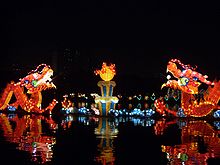Mooncake Festival
| Mid-Autumn Festival | |
|---|---|

Mid-Autumn Festival decorations in Beijing
|
|
| Official name |
中秋节 (Zhōngqiū Jié in China, Taiwan, Malaysia, Singapore; "Tiong Chiu Jiet" in Taiwan, Jūng-chāu Jit in Hong Kong and Macau) Tết Trung Thu (Vietnam) |
| Also called | Mooncake Festival/Celebration |
| Observed by | China, Taiwan, Vietnam, Singapore, Malaysia |
| Type | Cultural, Religious |
| Significance | Celebrates the end of the autumn harvest |
| Observances | Consumption of mooncakes Consumption of cassia wine |
| Date | 15th day of the 8th lunar month |
| 2018 date | September 24 |
| 2019 date | September 13 |
| Related to | Chuseok (in Korea), Tsukimi (in Japan), Uposatha of Ashvini/Krittika (similar festivals that generally occur on the same day in Sri Lanka, Myanmar, Laos, Thailand and Cambodia) |
| Mid-Autumn Festival | |||||||||||||||||||||||||||

"Mid-Autumn Festival" in Traditional (top) and Simplified (bottom) Chinese characters
|
|||||||||||||||||||||||||||
| Chinese name | |||||||||||||||||||||||||||
|---|---|---|---|---|---|---|---|---|---|---|---|---|---|---|---|---|---|---|---|---|---|---|---|---|---|---|---|
| Traditional Chinese | 中秋節 | ||||||||||||||||||||||||||
| Simplified Chinese | 中秋节 | ||||||||||||||||||||||||||
| Literal meaning | "Mid-Autumn Festival" | ||||||||||||||||||||||||||
|
|||||||||||||||||||||||||||
| Min Chinese name | |||||||||||||||||||||||||||
| Traditional Chinese | |||||||||||||||||||||||||||
| Literal meaning | "Festival of the Eighth Month" | ||||||||||||||||||||||||||
|
|||||||||||||||||||||||||||
| Vietnamese name | |||||||||||||||||||||||||||
| Vietnamese | |||||||||||||||||||||||||||
| Chữ Nôm | |||||||||||||||||||||||||||
The Mid-Autumn Festival is a harvest festival celebrated by ethnic Chinese and Vietnamese people. The festival is held on the 15th day of the 8th month of the lunar calendar with full moon at night, corresponding to late September to early October of the Gregorian calendar with a full moon at night.
Due to ancient China's cultural influence, Mid-Autumn Festival spread to other parts of Asia. Mooncakes have also appeared in western countries as an exotic sweet.
The Mid-Autumn Festival is also known by other names, such as:
The festival celebrates three fundamental concepts that are closely connected:
Traditions and myths surrounding the festival are formed around these concepts, although traditions have changed over time due to changes in technology, science, economy, culture, and religion. It's about well being together.
The Chinese have celebrated the harvest during the autumn full moon since the Shang dynasty (c. 1600–1046 BCE). Morris Berkowitz, who studied the Hakka people during the 1960s, theorizes that the harvest celebration originally began with worshiping Mountain Gods after the harvest was completed. For the Baiyue peoples, the harvest time commemorated the dragon who brought rain for the crops. The celebration as a festival only started to gain popularity during the early Tang dynasty (618–907 CE). One legend explains that Emperor Xuanzong of Tang started to hold formal celebrations in his palace after having explored the Moon-Palace. The term mid-autumn (中秋) first appeared in Rites of Zhou, a written collection of rituals of the Western Zhou dynasty (1046–771 BCE).
Empress Dowager Cixi (late 19th century) enjoyed celebrating Mid-Autumn Festival so much that she would spend the period between the thirteenth and seventeenth day of the eighth month staging elaborate rituals.
...
Wikipedia
